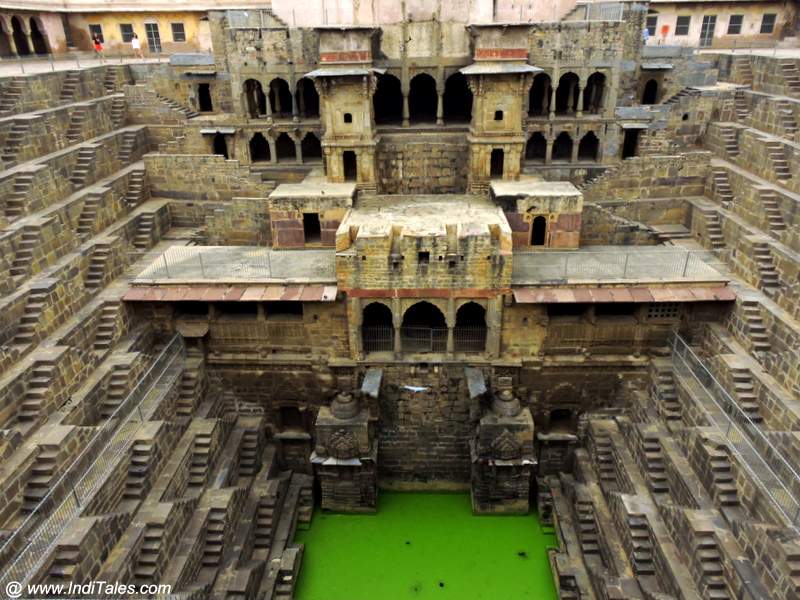
Chand Baori at Abhaneri Village in Rajasthan is the most photogenic step well of India. When you stand next to this 13 story deep step well with symmetric triangular steps leading to the water at the bottom, you cannot but be mesmerized. You, of course, understand that in the desert of Rajasthan, it is a practical water management solution. It also serves as a natural cooler in summer months. But, what inspired the people of those days to build it so beautifully. Were all the public spaces so beautiful in 9th CE? I wonder how India would have looked then.
History of Chand Baori – Abhaneri

Chand Baori is the oldest surviving step well in Rajasthan and probably India. It was built by the King named Chanda or Chandra of the Nikhumbha dynasty. The time of the stepwell is 8-9th CE making it 1200-1300 years old. Yes, it is older than Taj Mahal, Khajuraho Temples, and Chola Temples but younger than Ajanta and Ellora Caves.
It is named after the King who built it. The city was then called Abha Nagri.
Baori is a general name for step well – other names being – Bawdi, Vav, and Pushkarni. Anyway, let me show you the step-well as I saw it in the second decade of 21st CE.
Visiting Chand Baori – Abhaneri
Having seen so many wonderful images of the step-well – I had goosebumps as I entered the premises of the Baori through a raised pavilion. I first saw a group of women worshipping the Shivalinga. A few steps and the step well appeared in all its glory.
The architecture of Chand Baori

On three sides of this 19.5 meters deep step well are geometric steps. Steep triangular steps ensure that you get down or up sideways and not straight. I wonder if this was done just for aesthetics or there was a practical purpose as well. I could only think that going sideways maybe a little safe. It also allows multiple people to sit close to the water.
The fourth side has pillared corridors at multiple levels. Two balconies project towards the stepwell. They are adorned with the idols of Mahisasurmardini and Ganesha. The step-well also has an image of Sheshasayee Vishnu or the sleeping Vishnu. Here, I was told there is an image at one of the lower corridors. Since visitors are not allowed to enter the step well, it is not visible. Idea is that the stepwell or any water body is supposed to be an embodiment of Ksheersagar – the ocean of milk where Vishnu lives.

If you look closely you would see a shaft to pull water up from the stepwell. It is so well concealed in the structure that you more often than not miss it.
35,000 Steps at Chand Baori
In all, there are 35,000 steps on 13 levels at the step-well. The Baori gets narrow as it goes down.
I walked around to admire the Baori from all angles. The water at the bottom was of bright green color – it added its own vibrancy to the ambiance. I could only imagine how it would be to sit in those corridors in the summer heat of Rajasthan. To be surrounded by the beautifully carved images all around would have been quite an experience. How I wish, we can re-create some of these experiences for our and our next generations to come.
From my camera lens, I could zoom in and see some lovely carved doorjambs. The staircases follow the same pattern as the other three sides but on a larger scale. The arches, of course, tell you that they were later added as during the 8-9th CE India had no concept of arches like these.

Once I and my camera had a fill of step well, I looked around. The Baori is enclosed with a high wall and a corridor runs parallel to this. An ASI board informed me that the walled enclosure and the entrance are later additions and were not part of the original plan.
As of now, the corridors are full of excavated artifacts. There are stone sculptures of all kinds. I walked around trying to decipher a few, and here what I could find:

- Shiva Head in Red Sandstone, Shiva meditating, Shiva with Parvati
- Vishnu as Kalki Avatar, as Parashurama
- Karthikeyan
- Mahishasurmardini – a very finely carved one
- Brahma, Vishnu, Mahesh Panel
- Harshat or Harsiddhi Mata Temple
- Laxmi
- Jain Images
- Yaksha Statues
- Some exquisitely carved pillars
Abhaneri Festival
An annual 3-day Abhaneri festival happens at the beginning of Sharad Navratras. So, it would fall 10 days before Dussehra or 30 days before Diwali each year. My guide told me that for these 3 days, the step well is open to the public. In fact, a kind of diving competition happens among the young men in the village.
It is not surprising since Navratras celebrate the Shakti and there is Harshat Mata temple next to the Baori.
This place gets a lot of tourists. It is one of those places in India that gets more foreign visitors than Indians.
Harshat Mata Temple

About 100 meters to the west stands a solitary temple with a dome roof. It is dedicated to Harshat Mata who is also referred to as Harsiddhi Mata in many texts. She is supposed to be a goddess of happiness and Joy. Now, who would not like her blessings.
The Harshat Mata Temple was built by the same king at the same time. In fact, ancient step wells were always located next to a prominent temple. The only exception I have seen is Rani ki Vav in Patan. It is a small temple on a high platform that you need to approach through a flight of stairs.

I walked around the platform and saw the lovely depictions of Sunflower. Now, I had seen sunflower fields all the way on our drive to Abhaneri. It was lovely to see them on stone carved panels at this temple. They punctuate the other figurines all around the outer surface of the platform. It tells me that sunflowers have been around here at least since the time of this temple and step well. Finding sunflower in art is not common, across India and even Asia, it is the Lotus flower that dominates the art, followed by Hibiscus.
Amlaka
Harshat Mata Temple faces the east and it originally had a Nagar style shikhara also called Mahameru Shikhara. The remains of this can be seen in the form of broken Amlaka pieces around the temple. An Amlaka is the representation of Amla or Gooseberry fruits that sits on top of the temple Shikhara. Dome is obviously a medieval replacement. Within the Nagar Style, it is Panchratha style temple.

Notable sculptures at Harshat Mata temple are deities in the upper niches all around the temple. At the bottom level, you can see the Mangal Murtis of couples and Sur Sundaris. Parts of the original temple are profusely and finely carved.
There are board games engraved on the floor indicating that this was not just a place of worship but a community space as well.
The main idol inside the temple looks like a recent idol from its style. My guide opined that it was originally a Vishnu temple and not a Devi temple. I did not find a clue to that.
For me, it’s a small glimpse of the glorious past of this region.
Travel Tips

- Abhaneri is in Dausa district of Rajasthan, about 90 km from Jaipur. It is best to do it as a day trip from Jaipur.
- On the way, you can also visit Bhangarh Fort – the most haunted place in India.
- You need 30-60 minutes to see this place. I spent about 2 hours as I was exploring all possible sculptures.
- Guides are available at the site, but if you have read this post, you would not really need them.
Recommend you read following travel blog on Places to visit in Jaipur.
Jantar Mantar Jaipur – Must see Observatory of Sawai Jai Singh














I’ve been to Rajasthan quite a few times but never here, even though I’ve known about before. I intend to change that in January on my next trip and your post has re-inspired me! Actually, I’ll be going with my 72 year old mother so maybe we’ll do as you suggest and make it a day trip from Jaipur, along with Bhangarh Fort. Thanks for a great article!
Thanks, Verity. Have a great trip to Rajasthan and do share your experience of visiting Chand Baori & Bhangarh.
Hi Anuradha, your articles great with quite good on-site knowledge. But you have killed it in your last line where you are recommending not to take guide ? The poor fellow who showed you around in quest for his bread and butter and probably was nice to you, and you have insured to kill his livelihood? These places can only be preserved if they generate enough revenue for locals .. Do give it a thought ..
Arun Ji, I am actively working on creating a livelihood for locals through the heritage they have. However, I expect them to invest in learning and provide authentic information and not play to the galleries just because it sounds cool. As and when I meet knowledgable guides I make sure I put light on them, send them clients.
यहाँ तीन बार कार्यक्रम बनने के बाद भी जाना नहीं हो पाया।
आपके लेख ने उमंगों को फिर से हवा दे दी है।
संदीप जी, हमारा तो ध्येय ही आपकी उमंगों को हवा देना है, आशा है इस बार आप चाँद बावड़ी पहुँच ही जायेंगे. वैसे दोष आपका नहीं है। राजस्थान में हैं ही इतने दर्शनीय स्थल की आप उनमे खो जाते हैं।
You write, “In all, there are 35,000 steps on 13 levels at Chand Baori.” This is amazing and mesmerizing! Thanks for this wonderful write up. Just posted a tweet about it. One of the photos with the caption “First view of the steps” brought to my mind the goal of meditation as spelled out in Patanjali’s Yogasutras (1:3): तदा द्रष्टुः स्वरूपेऽवस्थानम् — Thereupon the seer (self) abides in its own nature.
Thank you, Srinivas Ji for encouraging us & for bringing the yoga sutra reference. It adds to the value of the post.
Lovely pics and great information about the step well and temple near it.
Thank you, Aadil. Long time – how have you been?
Absolutely, I still get goosebumps when I see the image of Chand Baori. Especially the way the baori is lit up during the Diwali is so mesmerising. I am planning to visit this place since past since couple of years but for some reason couldnt make it.
Urvesh – Do you have an image of Diwali at Chand Baori? It would be mesmerizing to see that.
I don’t have it. But I have seen it in on the internet. I am planning to visit baori soon and will definitely share some interesting images.
I’ve always wanted to visit one of these Baoris. I missed the one in Delhi during my last trip because I fell ill.
North, West and some of South India is full of these Baoris. It is amazing to see how they treat them as a public place along with water conservation.
its still pending in wishlist, your article gives me inspiration to visit it soon
Mayuri – may you get to go there soon enough.
This is absolutely amazing! I can see why you got goosebumps! 3 stories of gorgeous architecture
Sarah – the symmetry and geometry of the staircase and the gorgeous carvings are good enough to give you goosebumps 🙂
This is incredible! How in the world was this built its incredible! Besides the steps, all the attention to details in the steps. Im super impressed just from the pics, I cant even imagine how amazing it was in person
Harmony, this is a traditional architecture of step wells in western India. Besides this one, there is Rani ki Vav little south of this one which is 7 floors inside the ground and absolutely ornate. You should see them when you visit India.
The ancient step wells of India are some of the most fascinating things on earth for me. I can’t believe Chand Baori is over 1,000 years old. Great tips on how to make the most of visit.
Most step wells in India are 1000 year or more old. I guess this was our indigenous technology for water management in dry areas that get hardly any rainfall. Sometimes I feel, we should have water tourism that includes step wells.
WOW this is just so amazing, it’s hard to believe such an intricate structure could have been built so long ago! Thank you for sharing such great details about Chand Baori, it’s certainly being added to somewhere I’d love to visit to really grasp the size and magnificence!
Thanks, Suzy. Glad that you could discover a new destination for your travel wishlist on IndiTales. Stay Connected for many more gems of India.
I’d definitely agree that it has to be one of the most photogenic steps, it looks beautiful! I’d never consided visiting India, but If I do, I’d like to visit here.
Elle, this is on the most popular circuit that first-time visitors to India cover. It is called Golden Triangle covering Agra, Jaipur & Delhi. It lies between Agra and Jaipur.
What an interesting place to visit. I am yet to make it to India, but I definitely love immersing myself in history and seeing architecture from thousands of years ago. Its amazing to see what the thought processes were back then to create such brilliance. I’m sure I’ve seen this on Instagram before. That green water is just so vibrant.
Toni – it is amazing how our public spaces were so aesthetic – imagine sitting here in the evenings and chatting with your friends or celebrating festivals here.
35000 steps! That is incredible. Sometimes, when I see these structures, I too wonder about the past of our country. Everything seems incredible. Thank you Ma’m for inspiring us.
Amrita – I hope our shedding some light on these heritage structures would inspire some architects to use them as inspiration.
What a beautiful place. I’m sad I missed it in my travels. Is the well used on a regular basis by anyone. Did you find out what made the water so green?
Rosie, unfortunately, it is not in active use anymore. That is the reason you see algae on the water giving it bright green color. It is opened once a year when Abhaneri festival is celebrated for 3 days.
The detail in the architecture is incredible! The labor behind all that must have been all-consuming. And 35,000 steps…crazy!!!
It is incredible. I also wonder how they made it so perfectly.
I found this step well mesmerizing! (I bet you guessed it by the amount of time I took on taking a 1000 photos!) Somehow, but, I had a feeling that some knowledge is missing, that some things are maybe forgotten about the stone well’s history. Ironically we did not get a chance to take a picture from below. That would have been cool no? =D
Just the other day I saw the abhaneri step well again in an ad, or at least I think it’s that but I pretty much recognized it to the core.
Mesmerising it is. When the British brought the piped water, these step wells went into disuse. These are excellent water management strategies for arid regions like Rajasthan and Gujarat. What fascinates me is how they created them with love and affection – every stone is carved precisely and aesthetically.
Next time plan to go at the time of Abhaneri festival and you can take pictures from the bottom of the well 🙂
What gorgeous views here! Thank you for sharing this insightful post about 35,0000steps! Wow
Thanks, Karen. Chand Baori is a gorgeous step well.
Wow there is so much detail! Your pictures are lovely!
Thank you so much.
hello Ma’am….i really like the interface of your website.
Thank you, Mohini.
Anuradha ji, very informative piece but a bullet point on guides distressed me. Guides in India, genuine ones are excellent and should be hired and encouraged. That is the only way our tourism industry can flourish.
Rajaram ji, I want the guides in India to be professional & nothing can stop them from flourishing. Most guides unfortunately do not possess deep knowledge about the destination they are showing around.
Hi there Anuradha!
Just stumbled upon your awesome blog in a search trying to find the days in Abhaneri when the baoli is open fully. Can you please check to see if my calculations are correct for 2018? If the Abhaneri festival is 30 days before Diwali (07 Nov) and also 10 days before Dussehra (18 Oct), That means the festival starts 8th October.. I think?
I’m recently back from my 9th trip to India and although I’ve seen a lot of Baoli’s/stepwells, I’ve yet to make the trip to Chand Baori – I’ve no excuse really when you consider I usually stay in Jaipur for a week each trip lol! Next time though, definitely!
Have you or your followers seen the stepwell atlas? It’s a website (and app too!) showing the location of all the stepwells in India. I used it recently in Jodhpur to find and photograph/film over a dozen stepwells in the area. When I’m finished editing my Videos and photos, I’ll be uploading them to the website.
Currently reading Victoria Lautmans Vanishing Stepwells of India book too Which I recommend.
Keep up the good work
James
Arthur – your calculation is absolutely right. Abhaneri festival happens during the first 3 days of the Navratras which is same as 10 days before Dussehra and 30 days before Diwali. I am aware of the stepwell atlas project – they are doing a wonderful job.
I hope the Vanishing Stepwells of India would get redundant soon, as there is a huge initiative to revive the old waterbodies of India including step wells. Fingers Crossed.
Thank you for your encouraging words.
As you mentioned in a comment that Rajasthan has so many places that one gets lost into it. This being one of the places I am yet to explore.
I wanted to understand if there’s any pattern around 7 layers of the well… Wanted to explore if there’s any conscious attempt to relate such beautifully divinified stepwells as 7 layers of Patal
I never thought of 7 layers, but I know there is always a Murti of Sheshashayee Vishnu, and my interpretation is that it is a re-creation of Ksheersagar.
I visited Chand Baori three years back and also bhangarh. Amazing architect. RANI KI Vav is equally interesting. I was little disponted to see the area arround Baori and its aproach. Govt. Should develop the area arround it. chand Baori is not well publicised. Many people in Jaipur has not herd about it.
Lalit ji – it is one of those places that is more popular with tourists and photographers than locals.
Whenever I look at the ancient architecture of India, I always wonder how did they achieve this kind of symmetry and scale in the olden days.
A captivating article that takes readers on a journey through one of India’s most impressive architectural wonders. You have provides a detailed and insightful account of the history and cultural significance of Chand Baori. The article is accompanied by beautiful photos that truly capture the grandeur and beauty of the structure, which features a mesmerizing geometric design and intricate carvings. The author’s writing is engaging and informative, providing fascinating insights into the engineering and architectural techniques used to build this incredible monument. Thanks for sharing such a great article…
Your captivating portrayal of the intricate architecture and stunning symmetry of Chand Baori has left me mesmerized.
Your blog on Chand Baori at Abhaneri brilliantly showcases the allure of this iconic stepwell, immersing readers in its historical significance and captivating aesthetics through vivid descriptions and stunning visuals. It’s a delightful journey through India’s architectural heritage.